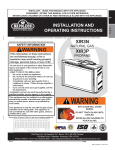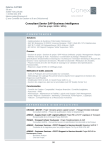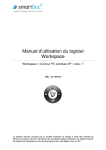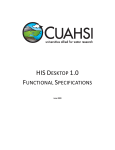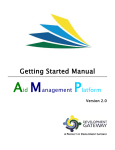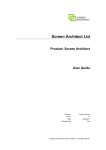Download Infoview XIR3 User Guide
Transcript
Infoview XIR3 User Guide 1 of 20 1. WHAT IS INFOVIEW? .................................................................................3 2. LOGGING IN TO INFOVIEW .......................................................................4 3. NAVIGATING THE INFOVIEW ENVIRONMENT ...........................................5 3.1. Home Page ...................................................................................................................... 5 3.2. The Header Panel ............................................................................................................ 5 3.3. Workspace Panel ............................................................................................................ 6 3.4. Maximising the Workspace ............................................................................................. 6 3.5. Document List & Workspace Toolbar.............................................................................. 6 3.6. Tree Panel ....................................................................................................................... 7 3.7. Details Panel ................................................................................................................... 7 3.8. Discussions Panel ........................................................................................................... 7 3.9. The Full Infoview Screen ................................................................................................ 8 4. SETTING USER PREFERENCES ...................................................................8 4.1. General Preferences ....................................................................................................... 8 5. SELECTING A REPORT ............................................................................. 10 6. RUNNING A REPORT ............................................................................... 11 6.1. Refreshing a Report ...................................................................................................... 12 6.1.1. Direct Entry of Parameters Method ................................................................................................... 12 6.1.2. List of Values Method .......................................................................................................................... 12 6.1.3. After the Report has Refreshed ......................................................................................................... 14 7. SAVING AND EXPORTING REPORTS ....................................................... 16 7.1. Saving a Report ............................................................................................................ 16 7.2. Saving a Report in Excel format (Exporting to Excel) .................................................. 17 7.3. Saving a Report in PDF format ..................................................................................... 17 7.4. Saving a Report in CSV Format ..................................................................................... 18 8. SEARCHING FOR A REPORT .................................................................... 18 9. ADDITIONAL FEATURES OF INFOVIEW .................................................. 19 9.1. Encyclopedia ................................................................................................................. 19 9.2. Scheduling Reports ....................................................................................................... 20 2 of 20 1. What is Infoview? Infoview is the tool we use to report out data held in a database, for example Banner. It is external to the database system but interfaces with it to extract data in a pre-defined format. Reports may be used for a variety of functions and can be stand-alone or used as a basis for an additional process. Banner operates very much on an individual basis – so you can look up students, courses and sections one at a time, but viewing all the students in your department, for example, is usually not possible in Banner. That’s where Infoview comes in, as it allows a mass extract of the Banner data to be displayed to you, which can then be viewed and printed, or downloaded and further manipulated. Infoview is entirely web-based, and is accessed via a web browser (i.e. Internet Explorer). View-only reports are available through Infoview, as well as Excel, Word, PDF and PowerPoint documents if they are published to the central repository. Throughout this guide there are references to ‘documents’ for this reason, though usually the document in question would be a report. Content available through Infoview is typically student data which should be treated as confidential. Therefore, if you wish to print content please make sure it is stored in a secure location and restrict access to authorised staff only. This is also true for files saved from Infoview in PDF or Excel format. This guide has been produced to show you the basics and help you get started with Infoview. Please read it carefully and refer to it for guidance. 3 of 20 2. Logging In to Infoview Infoview operates through an Internet browser, either Microsoft Internet Explorer or Firefox for PC users, or for Macintosh users, Safari. Double-click on your desktop shortcut icon for Infoview to launch your browser to the login page of Infoview: The login box looks like this: User Name: Enter your usual Computer Centre username Password: Enter your usual Computer Centre password (case sensitive) Authentication: Ensure this is set to Windows AD Then, click the Log On button to log into Infoview. 4 of 20 3. Navigating the Infoview Environment 3.1. Hom e P age The first screen you will see after logging in is the Home Page. This is divided into two main sections: 1. The Header Panel 2. The Workspace Panel 3.2. The Header P anel - Contains the Infoview Toolbar which allows you to perform various actions by clicking the relevant button: Key to Toolbar Button Function Returns you to Homepage Displays the Document List Opens some Infoview features like ‘Encyclopaedia’ Sends an object or instance to a destination Access to dashboards and analytics 5 of 20 Displays the Infoview online help Allows you to set how information is displayed Infoview product details Logs you out 3.3. W orkspace P anel The Workspace is the main portion of the Infoview screen, where content is displayed. It is where you would view and schedule Infoview reports, set your preferences, browse through the Document List etc. Toolbars and other options within the Workspace panel will change depending on what you are currently doing. 3.4. M ax im ising the W orkspace Some panels in Infoview can be hidden (and re-displayed) by clicking on the Hide/Show icons, which look like this: To expand the area of your workspace, you can hide unwanted panels. 3.5. Docum ent List & W orkspace Toolbar Click on the Document List button to display the folders and documents in Infoview. When the Document List is displayed in the Workspace, the Workspace Toolbar becomes available. Key to Workspace Toolbar: Button Function Shows folders in the Tree Panel (Switch to Folders) Shows Categories in the Tree Panel (Switch to Categories) Refreshes the Document List (Refresh) To create new documents in Infoview (admin rights only) To add existing documents to Infoview (admin rights only) To organise the selected document or folder (admin rights only) 6 of 20 Perform actions on the selected document or folder (admin rights only) Search for a document using a text string For navigating through pages in the Document List 3.6. Tree P anel When you click on Document List, the Tree Panel is visible on the left side of the Workspace. It displays folders/categories in a hierarchy and allows you to navigate through them. Please note: we use the Folder structure rather than Categories so all future references will be for Folders. When you select a Folder in the Tree Panel, its contents appear in the Details Panel. 3.7. Details P anel The Details Panel is visible when you view the Document List and displays the contents of the folder selected from the Tree Panel. The order documents are displayed in can be changed using sorts, and they can be modified, viewed, organised or scheduled if you have the appropriate access rights. 3.8. Discussions P anel The Discussions Panel will be covered in a later section in this user guide. To display it, click the icon in the bottom right hand corner of the Workspace. 7 of 20 3.9. The Full I nfoview Screen 4. Setting User Preferences This section describes what each of the preferences is for and provides the recommended setting. It is strongly suggested that you configure your preferences after logging in – they will then be saved for every subsequent login. 4.1. General P references Click the button on the Header Panel Toolbar. The Preferences page will appear in the Workspace Panel. The ‘General’ preferences are the only ones you need to use. They are specific to your username and will be retained for all subsequent logins so you only need to set them once. 8 of 20 We recommend this is set to Home, so when you log in to Infoview you will see the Home page first. If you only ever use a single Folder in Infoview, you can select to always see this folder first as default by clicking the radio button and clicking Browse… and then select the appropriate folder. We recommend setting this to Folder as the Infoview repository is organised by folders. There should be no need to refer to Categories. ‘Objects’ in this case means documents. We strongly recommend setting this to 100, so you see all documents within a Folder on one page, since folders do not generally contain more than 100 documents. Otherwise, you might not be able to see all the documents available without scrolling to the bottom and clicking the Next Page number icon. If a folder contains more than 100 documents, return to this Preference and increase the maximum. All boxes should be ticked so you can see the full details of each document. Bear in mind that not all documents will have a Description (this is additional information about the document, not the title) and ‘Owner’ in this case means the individual user who published the document to the repository. This option specifies how your selected document will be displayed. The above setting opens it in a new browser window. If you open another document it will display in this new window, overwriting the previous content. To have multiple documents open simultaneously, each in a separate window, select the third option – though be aware it can often be confusing having multiple Infoview windows open and the recommended setting is to stick to one document at a time. 9 of 20 These settings ensure your documents have the correct date and time stamp – leave them set to the defaults. Once you have completed your settings, click OK to save them – this returns you to the Home page view. 5. Selecting a Report Click the Document List button to display the Tree Panel on the left hand side of your Workspace. Some folders may have a + icon next to them – this is an indication that the folder contains sub-folders. If you click the +, the folder will expand to show the sub-folders it contains, in a branching structure. If a folder does not have + next to it, it is the end of that particular branch. To access documents, click on the + icon for the Public Folders folder, and then click the + next to the folder relevant for you. This may display sub-folders, which you need to drill down further into, or could be the top level folder. You need to know which folder the document you require is in. Click the relevant folder to see its contents displayed in the Workspace. Documents are listed alphabetically and if the maximum to display on the page has been set to 100*, all the documents contained within that folder are accessible by scrolling down. *If your folder contains more than 100 reports, change your maximum documents to display to a higher value in the Preferences. 10 of 20 You can see which folder is currently selected by whichever one is highlighted in blue in the Tree Panel. NB: some folders may contain documents other than Desktop Intelligence reports, e.g. PDFs or Word documents, but they will appear in the Workspace Panel in the same way as a report, with the appropriate file type displayed in the Type column. Select a document by single-clicking. Open a document by double-clicking. 6. Running a Report In your General Preferences, if you applied the setting to open a document in a new window, an additional Internet browser window will open when you double-click on the document. In the case of a report, the data displayed will be from when it was originally published. You need to refresh the report to see your required data, which usually involves entering specific parameters at the prompts. Some reports may not have prompts – these can be refreshed by clicking the the report window. button in the top right corner of Reports may have tabs at the bottom (e.g. Box 1 and 2, below), which display the same report in a different way. For example, many reports displaying student data have students ordered by surname on one tab, and in ID/candidate number order on another. Alternatively, a report may have different queries represented on individual tabs, or some tabs may have the data displayed in different formats e.g. graphs. Once you’ve refreshed the report (see 6.1.) ensure you have the tab you require selected. 11 of 20 6.1. Refreshing a Report There are 2 ways to refresh a report. 6.1.1. Direct Entry of Parameters Method The User Prompt Input panel on the left hand side of the screen can be expanded to show all available prompts for the report. If you know the parameters, type them directly into the prompt boxes. Then click the Run icon (Box 1). Be aware that you must type the parameter in the correct format. The report will not show any data if you deviate from the recommended format (may be listed as an e.g.) If you are not sure of the parameters, you cannot type them in directly and must refresh the report using the next method. 6.1.2. List of Values Method If you need to refer to a List of Values for each prompt, click on the Refresh Data button in the top right corner of the report window: Or, click on the Advanced button on the User Prompt Input panel. The Prompts window then opens: 12 of 20 To change a parameter for a prompt: • • Click the prompt you want to change in the top panel (Box 1) Possible values for that prompt will be listed in the panel below. If the list is long you may need to scroll down through the values. Select the value by leftclicking (Box 2) • Click on the icon (Box 3) to confirm it for the prompt Repeat this for each prompt where necessary, and click the Run Query button (Box 4) to refresh the report with these parameters. If the list of values is not up to date (e.g. an additional entry has been made or an existing one altered whilst you were choosing your parameters) you can refresh the list of values by clicking the refresh icon (Box 5) to get the latest list. For long lists of values, you can restrict what is displayed using the ‘Find’ feature – type a value into the search box: and click the Binocular icon to show only the values that match your search criteria. Use asterisks (*) as a wildcard, e.g. 3* to see all values that start with a 3. A small window will appear whilst the report is being refreshed: 13 of 20 This window also states how long the report took to refresh the last time it was run. So if it seems to be taking significantly longer than the ‘Last refresh time’ it is possible there has been an error and you may need to try again. Bear in mind some reports are more complex than others and return more data. These take longer to refresh! If you want to cancel a refresh, press the ESC key on the keyboard to abort. 6.1.3. After the Report has Refreshed The default View Mode is to only show one page of data at a time, so if the report takes up multiple pages, only the first page is shown, even if you scroll down. To see the additional pages you need to click the ‘Next Page’ button at the top of the screen (Box 1): Most reports should have a Page Number at the bottom of each page of the report so you can see the total number of pages for the report. To see the full report and scroll down through the pages, you must change the View setting: Click on the drop-down arrow next to the View button (Box 1), and select ‘Draft mode’ to see the report on one continuous page (HTML format, no page numbers) or select ‘PDF mode’ to view a paginated report(scrollable), with a PDF side bar to jump to bookmarks or specific pages. 14 of 20 Draft (HTML) mode: Use this mode for when you want to quickly view the data in the report, or when you want to find one particular piece of data. For that, you can use the Find functionality. At the bottom of the Prompts panel is the Find button panel will change to the panel to the Find panel: . Click this and the Prompts Enter your search criteria into the box indicated and click the Find Next button to jump to wherever that data item appears in the report. A common use for this might be to enter a Student ID to jump to them in the report. PDF Mode: 15 of 20 Use this View when you want to retain the pages and layout of the report. You can scroll down through the report, or select Pages or Bookmarks using the bar to the left of the report. You cannot use the Find feature as you can in Draft/HTML mode, but you can use a Search feature within the PDF (underneath the Bookmarks). You should also select this View mode if you want to print a report. NB: Bear in mind that when printing reports with multiple tabs, all the pages will print unless you specifically select only the pages you want. You can do this by leftclick and drag to select the pages from the menu bar on the left, then right-click and select Print Pages, or right-click any of the Bookmarks and click Print Pages. Alternatively, click the Print icon and specify which pages to print by entering page numbers. 7. Saving and Exporting Reports 7.1. Saving a Report When you run/refresh a report, you may wish to save the output to be referred to at a later date. Ideally, reports should be date-stamped at the bottom, as well as displaying the username of the person who refreshed the report, so there is a record of these details for any saved report. Saving the report is dependent on which View setting you have selected. If you have ‘Page mode’ or ‘Draft mode’ selected, the report output can be saved in one of three formats: Excel PDF CSV (Comma Separated Values) NB: if the PDF View setting is selected, you can only save output as PDF. Click on the ‘Document’ button in the top left corner of the screen (Box 1) then select ‘Save to my computer as’ (Box 2) to select the format (Box 3). 16 of 20 PLEASE NOTE: If you have a pop-up blocker for your Internet browser, the file could be blocked. To override this, hold down the CTRL key on the keyboard before you click which format you want. You will then see the File Download window. If you want to open the file to view the data you need to hold down CTRL before you click Open, to override the pop-up blocker again. 7.2. Saving a Report in Excel form at (Exporting to Ex cel) Saving in Excel format is essentially exporting the report into an Excel spreadsheet, representing the report as you see it in Infoview but within the cells, columns and rows of Excel. Sometimes this format isn’t suitable for a report, depending on the layout – if a report is heavily formatted, with multiple sections, breaks, headers and non-standard columns, it won’t translate very well to the Excel format. Often you will need to adjust columns and rows, and may need to un-merge cells. You may need to use CSV format instead (see section 7.4). 7.3. Saving a Report in PDF form at Use the method above but select PDF from the ‘Save to my computer as’ list, or if you have selected PDF mode as your View option, click the Save button on the Acrobat toolbar (Box 1): You cannot save a report displayed in PDF format as an Excel or CSV file. You need to switch back to HTML mode, using this button on the top left corner: 17 of 20 7.4. Saving a Report in CSV Form at CSV (Comma Separated Values) is a file format that is opened in Excel. It displays all the items of data, one item per cell, organised in columns. This can be useful for manipulating data (removing unwanted columns, editing data items) and for using the data for other purposes, e.g. a mail merge. Warning - this format may produce multiple rows for the same student, depending on the report setup. You may also find that additional columns that were not visible on the report are displayed in the CSV – this is due to some data items being used as conditions within the report but do not need to be shown. You can delete any columns that you don’t need. An example of a CSV file output in Excel (a report saved in CSV format, opened in Excel): NB: Whenever a report is saved into Excel, PDF and CSV format, it ceases to become ‘live’ data – it won’t be refreshed dynamically. Therefore if you save a report you should use the data immediately to ensure it is up to date – otherwise refresh the report again in Infoview and save the file again. 8. Searching for a Report The Workspace Toolbar contains an option to search for a report. This can help you locate a specific report without needing to scroll through the entire list, or if you don’t know which folder it’s in. The ‘Search title’ search will look through all the reports you 18 of 20 have access to and find any where the title is a complete or partial match to the text you’ve searched on. There are other searches available from the drop-down but the Search title is the recommended search. Type your search criteria into the search field and click the icon on the right. Only documents that meet your search criteria will be displayed in the Workspace Panel. If the results are not correct you may need to perform another search, and you can use incomplete entries, e.g. Prog to find reports with ‘Prog’ in the title. To do a more sophisticated search, select the Advanced Search option from the Search button drop-down, and fill it out as required: 9. Additional Features of Infoview 9.1. Encyclopedia Reports (and other documents) are usually given a title that makes it clear what the report is for. However, for more detailed information about a report such as exactly what it is used for, what prompts (if any) you can expect and comments on usage, refer to the Encyclopedia entry for that report. To access the Encyclopedia, first select the report with a single left-click, so it is highlighted in blue. Next, click on the ‘Open’ button (Box 1) and select Encyclopedia. This will open the Encyclopedia panel on the right side of the screen (Box 2). In the ‘Overview’ section you can see the Title, Description (if populated), Purpose and Usage for the report. If you click a different report with the Encyclopedia still open, the details will refresh for the selected report. To close the Encyclopedia panel, click on the tab icon (Box 2). Please bear in mind that not all reports will have an Encyclopedia entry. 19 of 20 9.2. Scheduling Reports This option allows you to take ‘snapshots’ of the data at specified times and over a set period, for example scheduling a report to run every day at 10am and 3pm. Reports can be scheduled to run overnight so the results are waiting for you first thing in the morning to reduce time spent running reports during office hours. You can either view the results in Infoview, or specify that they are sent to another user’s Infoview Inbox, or even sent (in one of several available formats) to someone via e-mail. This could be useful if, for example, you wanted to send up-to-date registers to course tutors. For full instructions on using the Scheduling functionality, please refer to the Infoview XIR3 Report Scheduling user guide. 20 of 20




















